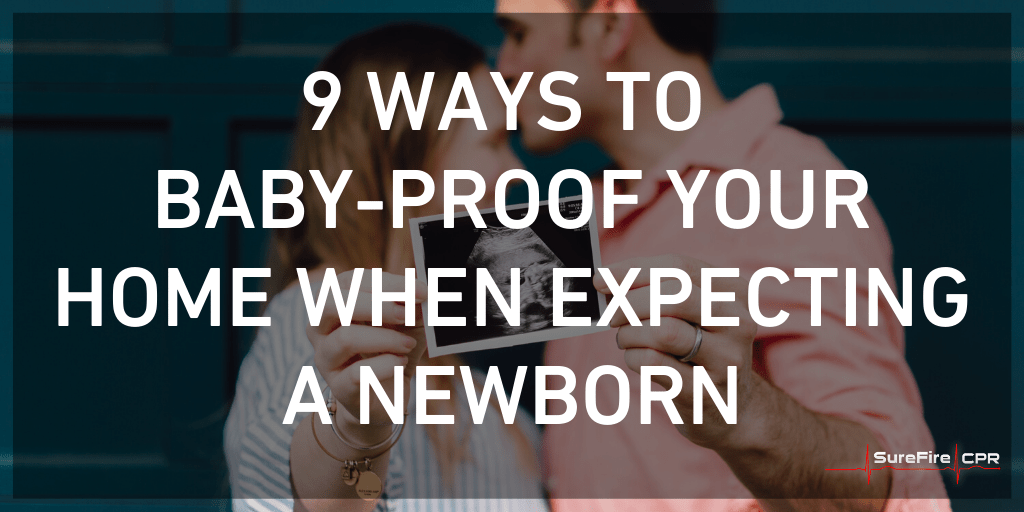Whether you are expecting your first baby or you are already a seasoned parenting pro, your number one goal is your child’s safety. For new additions to the family, it’s important to make a baby-proofing checklist and get your home as safe as possible before your newest addition to the family comes home from the hospital. Once you start parenting in full swing, you’re won’t have nearly as much time to do all of the baby-proofing required to keep your new loved-one as safe as possible in your home. Here to help you get started, our safety experts at SureFire CPR have put together this list of 9 ways to baby-proof your home or apartment when expecting a newborn. Start this next chapter of your life off right with our help, and enroll is life-saving courses with our award-winning team today!
Safety Ideas That Don’t Require Buying Anything
Wouldn’t it be great if you didn’t have to spend hundreds of dollars to baby-proof your home? (Think of all of the extra diapers and baby formula you could buy with the savings.) You’ll likely have to shell out some cash to prepare your home for a newborn, but not every step has a price tag. Start the baby-proofing process with these practical, 100-percent free tips.
Reorganize your cabinets.
With children out of the equation, cabinets are just another place to store whatever needs storing. With children in the mix, cabinets are little doors to a number of hazards. We’ll cover baby-proofing cabinets later on in this blog — but before you start doing that, your first step is to move everything potentially hazardous to shelves and cabinets that are above your head. If it’s above your head, it’s definitely above your toddler’s head. Need some more overhead storage space? Consider building hanging or floating shelves.
Prepare siblings and pets for the new addition.
Babies change things for everyone under your roof. Older siblings might think that your newest member of the house is a big doll to start playing with. This isn’t the case, as you know — and it’s on you to make sure your toddler knows too. First off, you should never leave your toddler alone with your baby. Be there with the two of them and discuss what the right kind of play they should do with their new sibling. Monitor their interactions to make sure that the kind of play they are attempting to do is the kind that won’t harm the baby. Vigilance is key with sibling interactions.
Pets are a different story. Most cities have pet training classes that are specifically tailored to train your pet on how to interact around a baby. Consider these if you have a rowdy dog. Sometimes, the best option with a pet that isn’t good around kids is adoption. It’s sad, but it’s a better option than having an unsafe home.
The Ones You May Have Already Thought Of
With the freebies out of way, it’s time to cover the no-brainers. These baby-proofing steps almost go without saying, but they’re important to dive into with a little extra detail. Without further ado, here are a few fundamentals you’ll need to cover in order to prepare your home for a new baby.
Get yourself some stair guards.
Babies are a funny breed. They typically sit there and sit there and sit there, hanging out, not doing all too much, and then BOOM! They’re crawling all over the place. And then before you know it, they’re walking all over the place. Babies and stairs don’t ever mix well. One is clumsy and the other one is steep. Get stair guards for the tops of your stairs and the bottoms. Crawling up the stairs can lead to tumbling down the stairs for a precocious baby.
Baby-proof your cabinets.
We’ve already covered reorganizing your cabinets — now it’s time to talk about baby-proofing them. Just like with the stairs, this is going to be one of your most important baby proofing jobs: making sure that every cabinet with dangerous items in it has a baby-proof lock. Do your due diligence on selecting a brand of cabinet-proofing device. Read parenting blogs, books, and reviews from trusted sources to make sure that the baby-proofing cabinet locks are going to get the job done. This means keeping out kids ages five and under.
Outfit all electrical outlets with safety covers.
Electrical systems in homes are a lot safer than the days when you were a kid, but that doesn’t mean you should cut corners by not covering up your outlets. Get outlet covers that are large enough so they don’t become a problem in themselves when your baby tries to pry them off the outlets to suck on as a new binky alternative.
The Ones You (Maybe) Haven’t Thought Of:
With the basics out of the way, it’s time to cover a few preparation steps that may have slipped your mind. While not as commonly considered, these steps are absolute essentials for any home expecting a newborn.
Make a plan for your electronics.
If you have it in your budget, strongly consider anchoring your TV to your wall so it doesn’t become another hazard that your baby can possibly tip over. Have a plan to keep cords wrangled up and generally out of reach of your baby. You don’t want them tangling them up anywhere near your child’s neck. Cable guards are good ideas to keep your baby from pulling out a stray chord and causing some harm to themselves or to your expensive electronics.
Take a CPR and First Aid course.
Even the best baby-proofed house isn’t immune to accidents. In case of an emergency involving your infant or toddler, you need to be prepared. An excellent way to do this is to take a CPR certification course, which will teach you how to administer CPR to infants and children as well as adults. Another important certification course to take is Basic First Aid, which will teach you how administer aid to child and adult victims suffering from asthma attacks, muscle and bone injuries, seizures, trauma, falls and allergic reactions. Those in search of a consolidated class entirely focused on emergency care for children can take a Pediatric First Aid and CPR certification course.
Safeguard your stovetops.
Stoves are one of the more dangerous appliances in your house because they are both a burn risk and an inhalation risk for children. Babies love to fiddle with knobs and one of the most fiddle-able nobs out there are stove top knobs. Before long, you can have your whole home filling up with gas because your baby turned a knob on the stove. Get stove knob covers so the only people who can actually turn the knobs on the stove are the people cooking on it. On a related note, start getting into the habit of cooking on the back burners of the stove. You don’t want a curious little hand reaching up and touching an open flame or a burner that is still in the process of cooling down. If you are cooking with the oven, keep the baby out of the kitchen entirely.
Designate a spot for your guests’ stuff.
So, you’ve baby-proofed your entire place and you can sleep easy. There’s still another factor that will change—even if the best baby-proofed fortress. That factor is your houseguests and their items. New things are prime sources of your baby’s attention. Purses and other small containers typically carry a number of things that your baby can choke on. An unfortunate number of these things are also shiny, so they are very tempting for your baby to grab and bite. Be sure to always, always keep guest’s purses and coats (you never know what’s in the pockets) in places that are out of reach for your little one. Closets are good options as well as countertops that are more than 3 feet high.
Ensure Your Newborn’s Safety With Our Team at Surefire CPR
Home safety starts and ends with your initiative and your skills. If you are in the Southern California area and wanting to take a PALS or PEARS course to prepare for the addition of the newest member of your household, your best bet is right here at Surefire CPR of Southern California. Our instructors have years of pediatric life-saving experience and our classes are fast-paced and crammed with tons of information and hands-on practice. When you complete a course with us, so you’ll be ready to jump into action in the event of any emergency involving your baby. Take the next step in baby safety — enroll with our award-winning team today!









